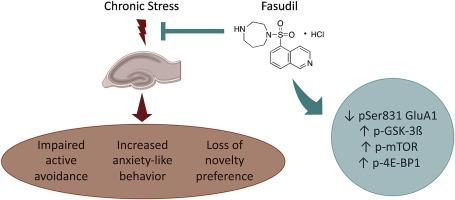Neurobiology of Stress ( IF 5 ) Pub Date : 2020-06-13 , DOI: 10.1016/j.ynstr.2020.100234 Luciano Román-Albasini , Gabriela Díaz-Véliz , Felipe Antonio Olave , Felipe Ignacio Aguayo , Gonzalo García-Rojo , Wladimir Antonio Corrales , Juan Pablo Silva , Ana María Ávalos , Paulina S. Rojas , Esteban Aliaga , Jenny Lucy Fiedler

|
Several lines of evidence suggest that antidepressant drugs may act by modulating neuroplasticity pathways in key brain areas like the hippocampus. We have reported that chronic treatment with fasudil, a Rho-associated protein kinase inhibitor, prevents both chronic stress-induced depressive-like behavior and morphological changes in CA1 area. Here, we examined the ability of fasudil to (i) prevent stress-altered behaviors, (ii) influence the levels/phosphorylation of glutamatergic receptors and (iii) modulate signaling pathways relevant to antidepressant actions. 89 adult male Sprague-Dawley rats received intraperitoneal fasudil injections (10 mg/kg/day) or saline vehicle for 18 days. Some of these animals were daily restraint-stressed from day 5–18 (2.5 h/day). 24 hr after treatments, rats were either evaluated for behavioral tests (active avoidance, anxiety-like behavior and object location) or euthanized for western blot analyses of hippocampal whole extract and synaptoneurosome-enriched fractions. We report that fasudil prevents stress-induced impairments in active avoidance, anxiety-like behavior and novel location preference, with no effect in unstressed rats. Chronic stress reduced phosphorylations of ERK-2 and CREB, and decreased levels of GluA1 and GluN2A in whole hippocampus, without any effect of fasudil. However, fasudil decreased synaptic GluA1 Ser831 phosphorylation in stressed animals. Additionally, fasudil prevented stress-decreased phosphorylation of GSK-3β at Ser9, in parallel with an activation of the mTORC1/4E-BP1 axis, both in hippocampal synaptoneurosomes, suggesting the activation of the AKT pathway. Our study provides evidence that chronic fasudil treatment prevents chronic stress-altered behaviors, which correlated with molecular modifications of antidepressant-relevant signaling pathways in hippocampal synaptoneurosomes.
中文翻译:

法舒地尔长期治疗对慢性应激雄性大鼠的抗抑郁相关行为和突触分子影响
一些证据表明,抗抑郁药可能通过调节海马等关键脑区的神经可塑性通路起作用。我们已经报道了用fasudil(一种Rho相关的蛋白激酶抑制剂)进行长期治疗可预防慢性应激诱导的抑郁样行为和CA1区域的形态变化。在这里,我们研究了法舒地尔(i)预防压力改变行为,(ii)影响谷氨酸能受体的水平/磷酸化和(iii)调节与抗抑郁作用有关的信号传导途径的能力。89只成年雄性Sprague-Dawley大鼠接受腹腔内法舒地尔注射(10 mg / kg /天)或生理盐水载体治疗18天。从第5-18天(2.5小时/天)开始,其中的一些动物每天都要承受约束压力。治疗后24小时,对大鼠进行行为测试(主动回避,类似焦虑的行为和对象定位)进行评估,或对海马全提取物和富含突触小体的组分进行安乐死进行western blot分析。我们报告法舒地尔预防主动回避,焦虑样行为和新颖的位置偏好的压力引起的损害,而在未受压力的大鼠中没有作用。慢性应激减少了整个海马体中ERK-2和CREB的磷酸化,并降低了GluA1和GluN2A的水平,而没有法舒地尔的作用。但是,法舒地尔减少了应激动物中突触的GluA1 Ser831磷酸化。此外,法舒地尔在海马突触神经小体中均与mTORC1 / 4E-BP1轴的激活同时阻止了Ser9处GSK-3β的应力降低磷酸化,这提示了AKT途径的激活。



























 京公网安备 11010802027423号
京公网安备 11010802027423号